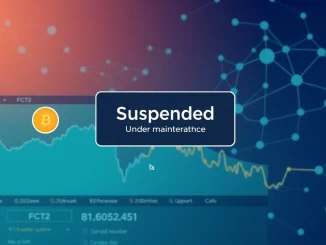
In the volatile world of cryptocurrency, where fortunes can be made and lost in the blink of an eye, trust is paramount. But what happens when that trust is deliberately undermined? CryptoQuant CEO Ki Young Ju has ignited a firestorm in the altcoin market with his recent explosive statements, accusing some projects of engaging in ‘number manipulation.’ This alarming revelation casts a dark shadow over the space, forcing investors to question the authenticity of the projects they are backing. Are all altcoins created equal, or are some masking their true nature behind inflated metrics? Let’s delve into this critical issue and understand the implications for the future of altcoin investments.
The Alarming Trend of Altcoin Number Manipulation
Ki Young Ju’s blunt assessment on X (formerly Twitter) has sent ripples across the crypto community. He didn’t mince words, stating that while not all altcoins are ‘shitcoins,’ a segment is actively involved in ‘number manipulation.’ This practice, he describes as ‘disgusting,’ involves artificially inflating engagement metrics on platforms like X and GitHub to create a false impression of community activity and developer progress. But what exactly does this ‘number manipulation’ entail, and why is it so concerning?
- Inflated Social Media Metrics: Some altcoin projects are suspected of using bots or paid services to boost their follower counts, likes, retweets, and comments on social media platforms, particularly X. This creates a deceptive image of a vibrant and engaged community.
- GitHub Activity Misrepresentation: GitHub, a crucial platform for open-source projects, is also allegedly being manipulated. Projects might create fake commits, branches, or contributions to appear actively developed, even when genuine progress is minimal.
- Deceptive Marketing Tactics: Beyond just inflating numbers, some projects employ misleading marketing campaigns that exaggerate partnerships, technological advancements, or adoption rates to lure investors.
This manipulation is not just about vanity metrics; it’s a calculated strategy to deceive potential investors into believing in the project’s legitimacy and growth potential. It preys on the Fear of Missing Out (FOMO) and can lead to significant financial losses for unsuspecting individuals.
CryptoQuant CEO Ki Young Ju’s Disgusting Revelation
Why is Ki Young Ju, the CEO of a reputable on-chain data analytics firm like CryptoQuant, speaking out now? His statement isn’t just a casual observation; it’s a serious warning based on data and insights into the cryptocurrency market. CryptoQuant specializes in analyzing blockchain data to provide transparency and identify market trends. When the CEO of such a firm raises concerns about number manipulation, it carries significant weight.
Ki Young Ju’s use of the word “disgusting” highlights the ethical implications of these practices. He is not just pointing out a market inefficiency; he is condemning a behavior that undermines the principles of transparency and honesty that the crypto space should ideally uphold. His statement serves as a crucial wake-up call for investors to be more vigilant and critical in their assessment of altcoin projects.
How to Spot Altcoin Number Manipulation Tactics
So, how can you, as an investor, protect yourself from falling victim to these deceptive practices? Identifying crypto scams disguised as promising altcoins requires a multi-faceted approach. Here are some actionable insights to help you discern genuine projects from those engaging in manipulation:
- Scrutinize Social Media Engagement:
- Look beyond follower counts. Analyze the quality of engagement. Are comments generic or do they reflect genuine discussion and questions about the project?
- Use tools to analyze follower demographics. A sudden surge in followers from suspicious or inactive accounts can be a red flag.
- Check for consistency in engagement across different platforms. Discrepancies might indicate manipulation on specific channels.
- Deep Dive into GitHub Activity:
- Examine the commit history. Are commits frequent and meaningful, or are they superficial and repetitive?
- Assess the developer community. Are there diverse contributors, or is activity concentrated around a few suspicious accounts?
- Look for evidence of real code development and problem-solving, not just cosmetic changes.
- Evaluate Website and Marketing Materials:
- Be wary of overly hyped language, unrealistic promises, and a lack of concrete details about the technology or roadmap.
- Verify partnerships and endorsements. Are they legitimate and verifiable, or are they vague and unsubstantiated?
- Check for transparency regarding the team, advisors, and tokenomics. Legitimate projects are usually open and forthcoming with this information.
- Utilize On-Chain Data Analysis:
- Tools like CryptoQuant, founded by Ki Young Ju, can provide valuable insights into token distribution, transaction activity, and exchange flows.
- Look for anomalies or patterns that might indicate manipulation, such as sudden spikes in trading volume or unusual token movements.
- Track the project’s development activity on the blockchain itself. Is the on-chain activity consistent with the project’s claims?
It’s crucial to remember that due diligence is your best defense against crypto scams. Don’t rely solely on surface-level metrics or hype. Invest time in researching the project’s fundamentals, team, technology, and community. If something seems too good to be true, it probably is.
Protecting Yourself from Crypto Scams in the Altcoin Market
The altcoin market, while offering potentially high rewards, is also rife with risks. The issue of altcoins engaging in ‘number manipulation’ is just one facet of these risks. To navigate this complex landscape safely, consider these essential steps:
| Actionable Steps | Description |
|---|---|
| Independent Research | Don’t rely solely on information provided by the project itself. Seek out independent reviews, analyses, and community discussions. |
| Community Sentiment Analysis | Gauge the genuine sentiment within the community. Are people asking critical questions, or is it just an echo chamber of hype? |
| Team Verification | Research the team members’ backgrounds and experience. Are they credible and transparent about their identities? |
| Tokenomics Review | Understand the token distribution, supply, and vesting schedules. Are they designed to benefit the project and community, or primarily insiders? |
| Risk Management | Never invest more than you can afford to lose. Diversify your portfolio and avoid putting all your eggs in one basket, especially with high-risk altcoins. |
By adopting a cautious and informed approach, you can significantly reduce your risk of falling prey to manipulative tactics and make more sound investment decisions in the altcoin market.
Conclusion: Navigating the Altcoin Landscape with Caution
Ki Young Ju’s outspoken warning about altcoin ‘number manipulation’ is a critical moment for the crypto community. It underscores the need for greater transparency, accountability, and due diligence within the altcoin space. While the potential for innovation and growth in altcoins remains immense, it’s essential to approach this market with a healthy dose of skepticism and critical thinking. By being vigilant, conducting thorough research, and relying on credible data sources, investors can navigate the altcoin landscape more safely and avoid the pitfalls of deceptive practices. Let this revelation serve as a catalyst for a more responsible and transparent crypto ecosystem, where genuine projects thrive and manipulation is exposed and rejected.



